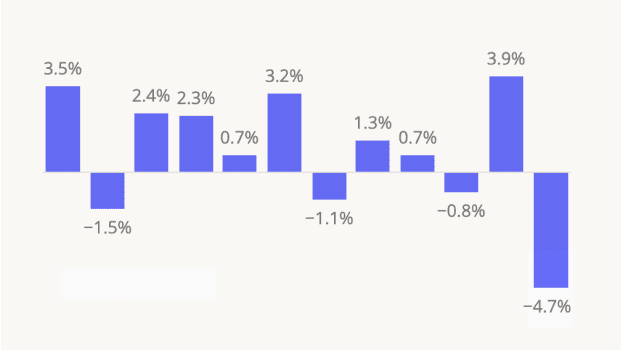Insights into the physical world anchored in location analytics

INSIDER
Report
5 Markets to Watch in 2026Find out why Salt Lake City, Reno, Indianapolis, Raleigh, and Tampa are Placer.ai's markets to watch in 2026.
Placer Research
December 5, 2025
Industry Trends
Year-Over-Year Visits to Grocery Stores by State
Article

Article
Starbucks and Dunkin’s LTOs Boost TrafficThe Kroger Co, is a leading player in the grocery store space, operating its epon lorem ipsum dolor sit amet, consectetur adipiscing elit, sed do eiusmod tempor incididunt ut labore et dolore magna aliqua. Ut enim ad minim veniam, quis nostrud exercitation ullamco laboris nisi ut aliquip ex ea commodo consequat. Duis aute irure dolor in reprehenderit in voluptate velit esse cillum dolore eu
Shira Petrack
Dec 12, 2025
2 minutes
Article
.avif)
Article
Placer.ai November 2025 Office Index: Post-Pandemic Record Occupancy The Kroger Co, is a leading player in the grocery store space, operating its epon lorem ipsum dolor sit amet, consectetur adipiscing elit, sed do eiusmod tempor incididunt ut labore et dolore magna aliqua. Ut enim ad minim veniam, quis nostrud exercitation ullamco laboris nisi ut aliquip ex ea commodo consequat. Duis aute irure dolor in reprehenderit in voluptate velit esse cillum dolore eu
Shira Petrack
Dec 11, 2025
3 minutes
Executive Insights

Executive Insights
Dutch Bros vs. Dave’s Hot Chicken: The Veteran and the Rookie in America’s Restaurant Expansion RaceThe Kroger Co, is a leading player in the grocery store space, operating its epon lorem ipsum dolor sit amet, consectetur adipiscing elit, sed do eiusmod tempor incididunt ut labore et dolore magna aliqua. Ut enim ad minim veniam, quis nostrud exercitation ullamco laboris nisi ut aliquip ex ea commodo consequat. Duis aute irure dolor in reprehenderit in voluptate velit esse cillum dolore eu
Kyle Inserra
Dec 10, 2025
3 minutes
Article

Article
Is lululemon Poised for a Holiday Rebound?The Kroger Co, is a leading player in the grocery store space, operating its epon lorem ipsum dolor sit amet, consectetur adipiscing elit, sed do eiusmod tempor incididunt ut labore et dolore magna aliqua. Ut enim ad minim veniam, quis nostrud exercitation ullamco laboris nisi ut aliquip ex ea commodo consequat. Duis aute irure dolor in reprehenderit in voluptate velit esse cillum dolore eu
Bracha Arnold
Dec 9, 2025
2 minutes
Latest

Article
Placer.ai November 2025 Mall Index: Early Strength Offsets a Softer Black FridayEarly November momentum and a 3.1% surge on Black Friday offset a softer weekend, driving overall visits up YoY across the three mall formats.
Shira Petrack
December 8, 2025
4 minutes

Article
Four Black Friday Signals for the 2025 Holiday Season Black Friday 2025 foot traffic trends show a holiday season defined by value-driven decisions, regional price sensitivity, and shifts toward budget-conscious categories. Longer in-store visits and standout gains for convenient, low-ticket coffee chains highlight shoppers’ deliberate, mission-focused approach to spending.
Shira Petrack
December 5, 2025
4 minutes

Article
Will Upscale Dining Lead the Holiday Season Again?Holiday dining patterns highlight upscale and fine-dining restaurants as the strongest seasonal performers, with coffee, casual dining, and eatertainment showing targeted lifts. Emerging YoY trends point to premium full-service concepts leading demand again this December.
Bracha Arnold & Lila Margalit
December 4, 2025
4 minutes

Article
Did Fewer Franchise Films Limit Thanksgiving’s Movie Theater Lift?Thanksgiving brought a healthy rise in movie theater traffic while still trailing 2024’s exceptional highs. The gap points to a growing reality in the theatrical space: In 2025, audiences show up strongest when franchises – and preferably, multiple franchises at once – lead the way.
Shira Petrack
December 3, 2025
3 minutes

Article
Darden Heads Into Holiday Season With Strong Visit TrendsDarden is heading into the holiday season with accelerating visit growth across its portfolio. Olive Garden, LongHorn, and Cheddar’s continue to deliver strong same-restaurant gains, while upscale banners like Seasons 52 and Ruth’s Chris are positioned for another robust holiday surge based on early 2025 trends.
Bracha Arnold
December 2, 2025
3 minutes

Article
How Did Grocery Stores Perform This Turkey Wednesday?Turkey Wednesday 2025 drove major traffic to grocery stores, with traditional supermarkets seeing the biggest visit spikes, while value chains led early-week shopping. Dwell times showed a shift from early stock-up trips to quick last-minute runs, and all analyzed major grocers posted year-over-year visit growth.
Lila Margalit
December 1, 2025
4 Minutes

Article
How Do Holiday Shopping Patterns Differ for Off-Price and Traditional Apparel?Holiday visitation trends differ across apparel segments. Off-price retailers sustain strong, steady traffic from value-seeking shoppers, while traditional brands rely on milestone-driven bursts like Black Friday. Differences in dwell time and shopper mix show how each segment is capturing a unique share of the holiday wallet.
Lila Margalit
November 26, 2025
4 minutes

Article
DICK's Sporting Goods Riding Positive Visit Trend into the HolidaysDICK’S Sporting Goods improved its YoY visit gap from -6.0% in Q1 to -2.6% in Q3 2025, with October visits up 2.2%. The retailer’s 5.0% YoY sales growth and expanding digital reach via Game Changer and House of Sport highlight strong holiday potential despite store closures.
Bracha Arnold
November 25, 2025
2 minutes

Article
Dollar Tree and Dollar General Thrive Amid Inflation FatigueDespite weakened consumer sentiment, Dollar Tree and Dollar General continue to post strong visit and sales growth. Both chains are capitalizing on shoppers’ focus on value, with consistent quarterly gains and October momentum signaling sustained strength into the holidays.
Bracha Arnold
November 24, 2025
2 minutes

Article
October 2025 Placer.ai Office Index: Continued MomentumThe October 2025 Placer.ai Office Index shows continued RTO momentum, with visits just 30.8% below 2019 levels. Miami and New York lead recovery, while San Francisco posts major YoY gains. Yet hybrid habits persist - Friday remains a quiet day, signaling an evolving workweek balance.
Lila Margalit
November 24, 2025
3 minutes

Article
Department Stores Ahead of the Holidays Following uneven Q3 results, department stores rebounded in October 2025. Bloomingdale’s led gains, and key shopping days like Black Friday promise to deliver another lift as the holiday season approaches.
Bracha Arnold
November 20, 2025
4 minutes

Article
Red Cup Day 2025 Outperforms Last Year With Bigger Crowds Than BearistaStarbucks’ 2025 Red Cup Day drew higher visits than both the Bearista launch and previous years. Placer.ai data shows visits jumped 44.5% above average as customers lined up for limited-edition cups and holiday drinks – proving that buzz, exclusivity, and timing continue to drive Starbucks’ seasonal success.
Lila Margalit
November 19, 2025
3 minutes





.png)
.png)

.png)
.png)


.png)
.png)









.svg)